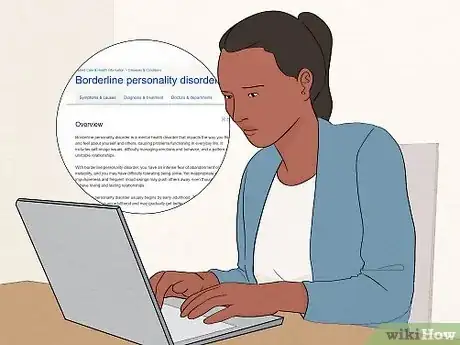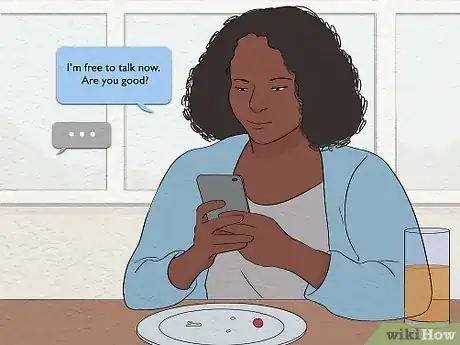This article was co-authored by Moshe Ratson, MFT, PCC. Moshe Ratson is the Executive Director of spiral2grow Marriage & Family Therapy, a coaching and therapy clinic in New York City. Moshe is an International Coach Federation accredited Professional Certified Coach (PCC). He received his MS in Marriage and Family Therapy from Iona College. Moshe is a clinical member of the American Association of Marriage and Family Therapy (AAMFT), and a member of the International Coach Federation (ICF).
There are 25 references cited in this article, which can be found at the bottom of the page.
Dating someone with BPD comes with unique challenges. It can feel like a rollercoaster ride at times! Why is your partner suddenly acting suspicious? Why are they pushing you away? What’s up with all of the mixed messages? The BPD relationship cycle explains this behavior, and learning about each stage will help you gain a deeper understanding of your partner. Maintaining a romantic bond isn’t easy when one person has borderline personality disorder, but if both partners are invested, it is possible. Keep reading to find out more about the BPD relationship cycle as well as steps you can take to improve your relationship.
Things You Should Know
- Recognize that BPD makes emotional regulation difficult. Your partner’s actions are manifestations of a mental illness; their behavior is not a reflection of who you are.
- Your partner might be crazy about you one day and angry with you the next. They likely have wild mood swings that cause them to act needy and then distance themselves.
- Improve your relationship by engaging in therapy, communicating productively, defining boundaries, and practicing self-care.
- Take care of your needs by attending a support group, spending time with friends, and pursuing your own hobbies.
Steps
Stages of the BPD Relationship Cycle
-
1Idealizing During this initial “honeymoon phase,” your partner with BPD is extremely enthusiastic about the relationship. They think you’re absolutely perfect; you’re everything they’ve been searching for! Things move fast, and you’re caught up in the passion and excitement. It feels great to be loved so deeply.[1]
- Your partner may mirror your interests since a symptom of borderline personality disorder is an unstable and shifting self-image.[2] You collect Happy Meal toys? Absolutely fascinating! You love to watch water polo? What a coincidence, your partner does too!
-
2Neediness & Hypersensitivity Your partner feels insecure during this stage. They watch carefully for signs of rejection and treat you with suspicion.[3] The thought of separation sends them into a panic, even if you’re only planning a weekend trip.[4] You may feel smothered by their constant need for attention.
- A person with BPD engages in irrational efforts to avoid being left alone.[5] For example, your partner might try to entice you to stay in bed longer in the morning, even though that would make you late for work.
- Your partner is hypersensitive during this stage; they can misinterpret your words or actions and feel deeply hurt.[6] Say your partner sends you a text while you’re busy driving. When you check your phone later, you’re surprised to find a string of angry messages saying you “clearly don’t care about them" because you didn't respond immediately.
- Your partner’s behavior has roots in two aspects of their BPD diagnosis: stress-related paranoia and fear of abandonment. [7] They often feel guilt and shame because of their actions, but the impulse to behave this way is very strong.[8]
Advertisement -
3Provoking & Testing Your partner’s doubts about your commitment are likely escalating. They crave evidence of your love, so they provoke, manipulate, and test you to gauge your loyalty.[9] Your reaction is seen as evidence of how much–or how little–you value them.[10] You might feel confused by their muddy logic and frustrated that you have to jump through hoops to show you care.
- Imagine that your partner with BPD begs you to cancel your plans with friends so the two of you can watch a movie together instead. If you agree to cancel, it’s proof that you love them. If you choose to hang out with your friends, it’s perceived as utter rejection.
- One symptom of borderline personality disorder is constant feelings of worthlessness.[11] Because people with BPD battle nonstop self-negativity, they seek continual reassurance from outside sources.
-
4Distancing & Devaluing When you do something your partner perceives as “wrong,” it’s as though a switch is flipped. Even though they were wild about you a day ago, now you’re viewed as a horrible person.[12] Your partner with BPD pulls away from you. As they rapidly swing from totally adoring you to completely devaluing you, you can experience emotional whiplash.[13]
- Black-and-white thinking, or “splitting,” is common in people with borderline personality disorder.[14] They have a tendency to think of people as all good or all bad, heroes or villains. It’s a struggle for them to view others realistically.[15]
- It’s painful to be treated this way, but try to remember: this is not a reflection of who you are as a person; it is a manifestation of your partner’s mental illness.
-
5Breaking Up The breakup can happen in a few different ways. Your partner could start an argument. Once that fuse is lit, they have trouble controlling their temper.[16] Or, they might just “ghost” you and disappear.[17] If you instigate the breakup, your partner probably offers desperate explanations and begs you to stay.
-
6Downward Spiral & Reconnecting Post-breakup, your ex experiences a downward spiral of depression and self-destructive behavior. They may drink too much, engage in risky sex, or rack up debt.[20] Deliberate self-harm and suicidality are not uncommon.[21] After some time has passed, they'll reach out to you with hopes of repairing the relationship.
- Take threats of suicide seriously. Immediately call emergency services so a professional can determine how dangerous the situation is.[22] This shows your ex that you don’t wish them harm, but you refuse to be drawn in by their chaos. You are not responsible for the outcome of your ex’s choices.
- If you agree to give the relationship another try, the cycle begins again. That is, unless the two of you put in the therapeutic work to break the pattern.
Warnings
- If you’re experiencing abuse, the National Domestic Violence Hotline can help. In the US, call 1-800-799-7233, or text START to 88788.[46] If you need help right away, call emergency services.⧼thumbs_response⧽
Expert Interview

Thanks for reading our article! If you'd like to learn more about dealing with personality disorders, check out our in-depth interview with Moshe Ratson, MFT, PCC.
References
- ↑ https://www.mind-diagnostics.org/blog/borderline-personality-disorder/what-is-the-borderline-personality-disorder-relationship-cycle
- ↑ https://www.helpguide.org/articles/mental-disorders/borderline-personality-disorder.htm
- ↑ https://www.psychologytoday.com/us/basics/borderline-personality-disorder
- ↑ https://www.helpguide.org/articles/mental-disorders/borderline-personality-disorder.htm
- ↑ https://www.nhs.uk/mental-health/conditions/borderline-personality-disorder/symptoms/
- ↑ https://youtu.be/ehOMsCOwLjM?t=48
- ↑ https://www.nyp.org/bpdresourcecenter/borderline-personality-disorder
- ↑ https://www.helpguide.org/articles/mental-disorders/borderline-personality-disorder.htm
- ↑ https://youtu.be/ehOMsCOwLjM?t=77
- ↑ https://www.psychologytoday.com/us/blog/unified-theory-happiness/202106/how-deal-borderline-personality-disorder
- ↑ https://www.nyp.org/bpdresourcecenter/borderline-personality-disorder
- ↑ https://youtu.be/ehOMsCOwLjM?t=103
- ↑ https://www.helpguide.org/articles/mental-disorders/borderline-personality-disorder.htm
- ↑ https://www.borderlinepersonalitydisorder.org/family-connections/family-guidelines/
- ↑ https://www.borderlinepersonalitydisorder.org/family-connections/family-guidelines/
- ↑ https://www.helpguide.org/articles/mental-disorders/borderline-personality-disorder.htm
- ↑ https://youtu.be/ehOMsCOwLjM
- ↑ https://www.nyp.org/bpdresourcecenter/borderline-personality-disorder
- ↑ https://www.nyp.org/bpdresourcecenter/borderline-personality-disorder
- ↑ https://www.helpguide.org/articles/mental-disorders/borderline-personality-disorder.htm
- ↑ https://www.nyp.org/bpdresourcecenter/borderline-personality-disorder
- ↑ https://www.thehotline.org/resources/when-my-partner-threatens-suicide/
- ↑ https://www.borderlinepersonalitydisorder.org/what-is-bpd/treating-bpd/
- ↑ https://www.ncbi.nlm.nih.gov/pmc/articles/PMC7455386/
- ↑ https://www.psychologytoday.com/us/blog/understanding-ptsd/202209/splitting-in-borderline-personality-disorder
- ↑ https://www.psychologytoday.com/us/articles/201811/the-challenge-of-borderline-personality-disorder-in-a-relationship
- ↑ https://www.borderlinepersonalitydisorder.org/what-is-bpd/treating-bpd/
- ↑ https://www.borderlineintheact.org.au/living-with-bpd/bpd-myths-and-facts/
- ↑ https://www.nami.org/Blogs/NAMI-Blog/June-2017/Supporting-Someone-with-Borderline-Personality-Dis
- ↑ https://www.helpguide.org/articles/mental-disorders/borderline-personality-disorder.htm
- ↑ https://www.borderlinepersonalitydisorder.org/family-connections/family-guidelines/
- ↑ https://www.psychologytoday.com/us/blog/unified-theory-happiness/202106/how-deal-borderline-personality-disorder
- ↑ https://www.borderlinepersonalitydisorder.org/family-connections/family-guidelines/
- ↑ https://www.borderlinepersonalitydisorder.org/family-connections/family-guidelines/
- ↑ https://www.borderlinepersonalitydisorder.org/family-connections/family-guidelines/
- ↑ https://www.nami.org/Support-Education/Support-Groups
- ↑ https://www.psychologytoday.com/us/blog/the-couch/202107/can-someone-borderline-personality-disorder-love-you
- ↑ https://www.borderlinepersonalitydisorder.org/family-connections/family-guidelines/
- ↑ https://www.psychologytoday.com/us/articles/201811/the-challenge-of-borderline-personality-disorder-in-a-relationship
- ↑ https://www.psychologytoday.com/us/blog/unified-theory-happiness/202106/how-deal-borderline-personality-disorder
- ↑ https://www.borderlinepersonalitydisorder.org/family-connections/family-guidelines/
- ↑ https://www.safehorizon.org/our-services/safety-plan/
- ↑ https://988lifeline.org/
- ↑ https://screening.mhanational.org/content/need-talk-someone-warmlines/
- ↑ https://warmline.org/warmdir.html#directory
- ↑ https://www.thehotline.org/














































































Medical Disclaimer
The content of this article is not intended to be a substitute for professional medical advice, examination, diagnosis, or treatment. You should always contact your doctor or other qualified healthcare professional before starting, changing, or stopping any kind of health treatment.
Read More...